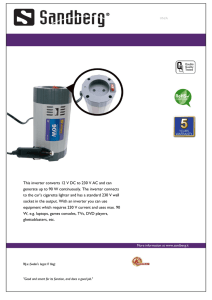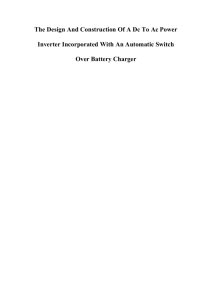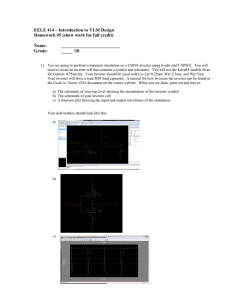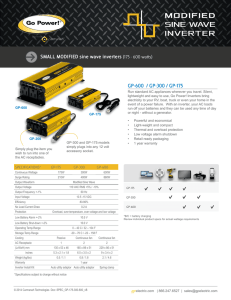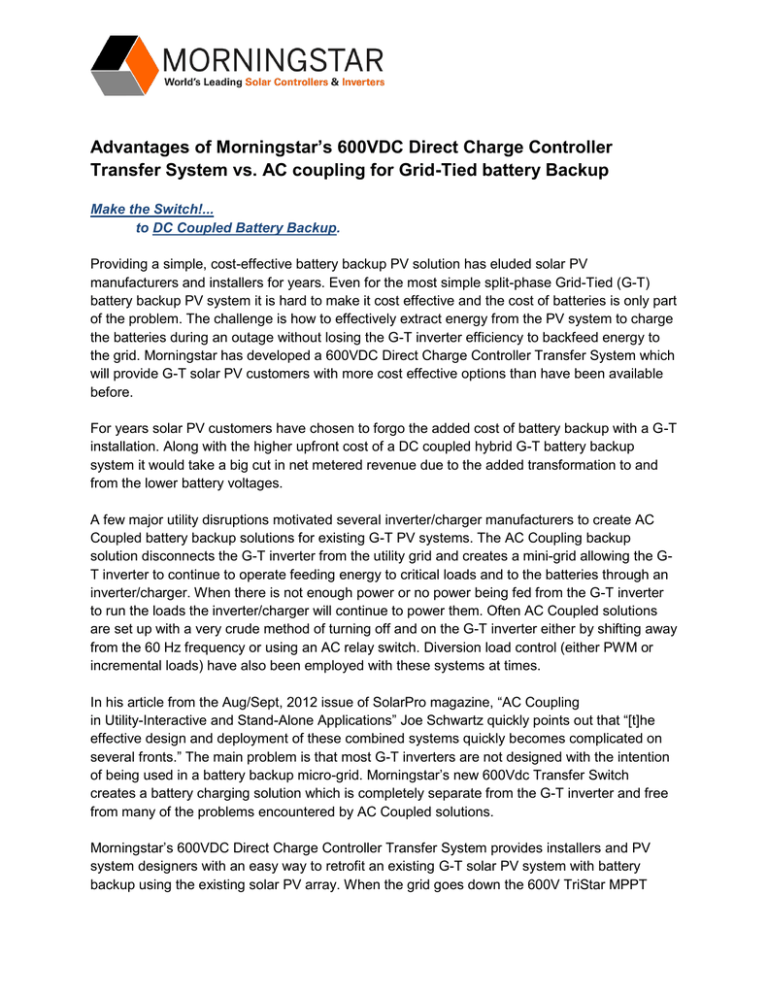
Advantages of Morningstar’s 600VDC Direct Charge Controller
Transfer System vs. AC coupling for Grid-Tied battery Backup
Make the Switch!...
to DC Coupled Battery Backup.
Providing a simple, cost-effective battery backup PV solution has eluded solar PV
manufacturers and installers for years. Even for the most simple split-phase Grid-Tied (G-T)
battery backup PV system it is hard to make it cost effective and the cost of batteries is only part
of the problem. The challenge is how to effectively extract energy from the PV system to charge
the batteries during an outage without losing the G-T inverter efficiency to backfeed energy to
the grid. Morningstar has developed a 600VDC Direct Charge Controller Transfer System which
will provide G-T solar PV customers with more cost effective options than have been available
before.
For years solar PV customers have chosen to forgo the added cost of battery backup with a G-T
installation. Along with the higher upfront cost of a DC coupled hybrid G-T battery backup
system it would take a big cut in net metered revenue due to the added transformation to and
from the lower battery voltages.
A few major utility disruptions motivated several inverter/charger manufacturers to create AC
Coupled battery backup solutions for existing G-T PV systems. The AC Coupling backup
solution disconnects the G-T inverter from the utility grid and creates a mini-grid allowing the GT inverter to continue to operate feeding energy to critical loads and to the batteries through an
inverter/charger. When there is not enough power or no power being fed from the G-T inverter
to run the loads the inverter/charger will continue to power them. Often AC Coupled solutions
are set up with a very crude method of turning off and on the G-T inverter either by shifting away
from the 60 Hz frequency or using an AC relay switch. Diversion load control (either PWM or
incremental loads) have also been employed with these systems at times.
In his article from the Aug/Sept, 2012 issue of SolarPro magazine, “AC Coupling
in Utility-Interactive and Stand-Alone Applications” Joe Schwartz quickly points out that “[t]he
effective design and deployment of these combined systems quickly becomes complicated on
several fronts.” The main problem is that most G-T inverters are not designed with the intention
of being used in a battery backup micro-grid. Morningstar’s new 600Vdc Transfer Switch
creates a battery charging solution which is completely separate from the G-T inverter and free
from many of the problems encountered by AC Coupled solutions.
Morningstar’s 600VDC Direct Charge Controller Transfer System provides installers and PV
system designers with an easy way to retrofit an existing G-T solar PV system with battery
backup using the existing solar PV array. When the grid goes down the 600V TriStar MPPT
controller can be used to charge a battery bank directly from the solar array. A standard 48V
inverter/charger can be installed for battery backup giving installers and customers more
effective and often lower cost options than have been available before.
This paper will discuss some common issues with AC Coupling and compare it to Morningstar’s
600VDC Direct Charge Controller Transfer System. It will show how retrofitting a G-T solar PV
system for battery backup can be very simple and non-problematic while still maintaining full
production for selling power to the grid during G-T operation.
Backup Sizing to Better Meet Your Needs
AC Coupling: The backup inverter(s) continuous rating in watts must be at least as large as
the PV array size in watts which is often much greater than the capacity required for the critical
backup loads. Many GT systems employ multiple GT inverters to meet the power requirements
of the PV system. Some manufacturers recommend that the battery based inverter must be
125% larger than the GT inverter that will be connected to it during a power outage. (i.e. a 5 kW
GT inverter could require a 6.25 kW battery based inverter)
Since most G-T inverters operate at max power only the inverter/charger has to be able to handle the
maximum power that can be generated. That means that the inverter/charger should be sized to at least
125% of the eSTC power of the connected PV array.
AC coupling Commercial PV systems which use larger GT inverters is very impractical since the
sizing requirements of the AC Coupled inverter/charger are so large. Part of the PV array can
be split into additional small GT inverter(s) for AC coupling but this adds additional cost and
many utilities will require additional permitting based on GT inverter power.
Direct Charge Controller Transfer: The TriStar MPPT 600V solar controller from Morningstar
can be connected to a larger array, even an array with over twice the controller’s nominal power
rating, and will always provide a current limited output. Therefore, it is not necessary to severely
oversize the charging capacity of the system.
“You can size Morningstar’s MPPT controllers well above the Maximum Nominal Solar PV Input rating
without damaging the controller and without the charging current exceeding the maximum output current
rating. The controller can limit output current and will run at 100% of rated current output and not higher.
The controller was designed with this power-shaving capability and when oversized it does not void the
warranty.” - Tech Article - “Morningstar’s TrakStar™ MPPT Technology & Maximum Input Power”
Large commercial systems with larger GT inverters can also be set up with standard BOS
equipment (combiners, recombiners and multiple inverter inputs) for incremental backup
charging. Many TS-MPPT 600V controllers can be used and adding more backup charging can
be implemented at any time.
Scalability - Much smaller does not necessarily mean much less.
The Scalability of the TS-MPPT-60-600V-48 controller can make it a much more cost effective solution
providing significantly more kWh of charging for every dollar spent.
Morningstar’s TriStar MPPT 600V Direct DC Charging (red line indicates max. charging power limit)
AC Coupling (Full Power required)
No Constraints on Battery Bank Capacity
AC Coupling: The battery bank sizing is driven by the size of the GT inverter instead of the
customers load requirements which often results in more cost and load support capacity than
actually desired. Generally this is about 100Ah per 1kW of PV on a 48V system which is often
more than what is needed for short term or infrequent backup situations.
For example a 6 kW GT inverter would be sized to a (~29kW) 600Ah/48V battery bank which is
more in keeping with an off grid home requiring a number of days of autonomy than a modest
load support system that will be operated for a short period. A typical DC coupled grid support
battery system which is designed to support telecommunications, lighting, refrigeration and
microwave cooking would likely be closer to ~14 kWh system - fully half the size and cost of the
AC coupled “solution”.
Battery charging rates faster than C/5 can be harmful to the batteries and reduce their life. Therefore, for
48V battery banks it is generally recommended that there should be >100Ah for every 1kW of PV power.
MS Direct Charge Controller Transfer: The 600V MPPT controller has full control over it’s
output power regardless of input power. So in addition to being usable in any backup system,
each controller’s output charge current can be set to match the batteries’ needed charge rate.
Many people may only want to consider a more affordable option. They may also not need very much
backup power for a few loads (refrigerator, lights, computers). There may also be space considerations. If
the minimum battery bank size can be cut by a half or more this can be a big step towards providing
people with a more affordable, conveniently sized solution.
Excellent charging efficiency by charging directly from the PV array.
AC Coupling: In an AC coupled system, battery charging is accomplished using a double
conversion charge process. Energy is lost both during the DC-AC conversion of the G-T
inverter onto the AC bus as well as during the AC-DC charge conversion of the backup inverter
charging the batteries.
MS Direct Charge Controller Transfer: The advantage is right in the name. The TriStar MPPT
TS_MPPT-60-600V-48 has a maximum efficiency of 97.5%. This option provides the best of
both worlds. Highly efficient G-T inverter selling and Morningstar’s highly efficient conversion
and fast MPPT tracking which is “Always on Track” for maximum energy storage.
High quality 4-stage charge control.
AC Coupling: Battery charging is often very poor quality with infrequent on/off style bulk
charging of the battery and no absorption charge. Regulation voltage is also an issue with
overcharging AGM Sealed batteries. UL mandated 5 minute reconnect delay makes things even
worse. For additional cost diversion control can be added, but this extra hardware and bulky
resistors (and waste heat) further complicates the system.
There have been complaints and concerns regarding the G-T inverter 5 minute minimum Frequency shift
shutdown. With no absorption charging the batteries may only be at 70-80% state of charge. That means
even on a sunny day the batteries may never reach a full state of charge and at the end of the day it can
really make a difference if the batteries are not fully charged. In addition, the G-T inverter shutting off and
on over and over can be annoyingly loud and a constant reminder that the batteries are not fully charged.
Some installers also get concerned that it is hard on the equipment to have it turn off and on over and
over.
Not only does the battery have to be sized to meet the GT inverter’s size, it also needs to be
sized to take into consideration that it will be starting each evening (which carries into the
following day) with approximately 20% of it’s capacity depleted.
MS Direct Charge Controller Transfer: Since the TS-MPPT-60-600V-48V controller is
charging the battery directly, its patented 4-stage charging algorithm provides accurate bulk,
absorption and float stages with temperature compensation and voltage sense for added
accuracy.
Morningstar’s solution will keep it simple and keep it charged
● No Diversion Loads
● No “second, independent means of controlling the battery charging process” as required by
690.72(B)(2)
● Continuous charging with no hesitation or disruption
● Continuously working to keep the batteries fully charged through Absorption and topping off in
Float.
● At the end of the day the batteries should be fully charged and as high a state of charge as
possible to make it through the night and start the next day with as high SOC as possible.
In some cases the array may be unavailable during power outage due the the very weather
condition that caused the outage. However, in this case the homeowner is no better off with an
AC coupled system since it cannot generate any more charging power than the smaller DC
Coupled system. The customer should be aware of this variable power availability and battery
sizing considerations should be taken accordingly. AC coupling may be more suitable for larger
daytime loads but a DC Coupling will always cost less and outperform any AC Coupled system
for the battery charging function. This is why AC coupling is practically never considered for PV
systems with only DC loads.
An AC coupled bus might be unstable without the capacity of the grid supporting it.
AC Coupling: AC Coupling employs a strategy that requires “fooling” the GT inverter into
thinking that an AC grid is present during a power outage. Some inspectors have required a
good amount of convincing that the additional connections and use of the GT inverter during
power outages does not affect safety or anti-islanding. If there is a voltage disruption on the AC
bus the G-T inverter charging will go offline waiting for 5 minutes of continuous AC power to
return to continue charging the battery bank.
Utility G-T inverter feed-in requirements stipulate the G-T inverter must shut off for a minimum of 5
minutes every time it is interrupted with a 5 minute wait before restarting regardless of the reason it is
shut off. Therefore every interruption will suspend all charging from PV array for at least 5 minutes for
every occurrence.
MS Direct Charge Controller Transfer: Our charging is DC direct to the battery. The G-T
inverter is not needed for charging and therefore the charging is not dependent on the
continuous operation of the GT inverter. The 600Vdc Transfer Switch and AC Grid disconnect
switch will create an independent Stand-Alone system which is completely isolated from the GT
inverter system.
AC-coupled systems often cannot connect to an ac-coupled string inverter and a
generator at the same time.
AC Coupling: When a generator is connected it is often simply not compatible or too
problematic.
Motor-driven generators often do not provide a pure sine wave or have voltage and frequency
regulation issues. Also, they can interrupt the frequency of the inverter/charger when turned on.
Therefore, the backup generators often need to be sized larger to power the loads while also
running longer to make up for the lost solar PV production.
EA 9.22.14 None of the foregoing about generator output quality or sizing is connected to AC
coupling and issues of power quality and generator sizing would result in any system DC or AC
coupled that incorporates a generator.
MS Direct Charge Controller Transfer: Morningstar’s G-T battery backup solution will provide
solar charging and the ability to connecting a backup generator independently of each other.
There will not be a problem with supplementing the generator with the inverter or continuing the
use the solar PV at the same time. During inclement weather and during evening hours a
modestly sized AC generator can be added to the system which will allow the batteries to “take
a break” and continue charging while the generator supports the loads. This will allow for
smaller generators, less waste of fuel and more use of the solar PV power.
AC Coupling is often an unsupported feature.
AC Coupling: Many Grid-Tie inverter manufacturers do not support the use of an AC coupled
system. They were designed to tie to the grid and not a local AC bus mimicking the grid.
Technical support, warranty coverage and legal obligations may be nullified leaving the owner
with no support, or worse yet, at risk of system malfunctions.
List of manufacturers who have indicated that they do not support AC Coupling. (as of July, 2014)
● AE Solar (Formerly PV Powered)
● Fronius
● Ingeteam
● Motech
● Power-One
MS Direct Charge Controller Transfer: Grid-Tied Inverters are designed to work with a DC
Disconnect with no problem.
By disconnecting the G-T inverter Morningstar’s solution does not try to make the inverter operate in a
mode that it was never intended for. No G-T inverter manufacturers will have an issue with Morningstar’s
600V transfer switch solution for battery backup since they are required to allow a DC disconnect switch
to be thrown during operation.
AC Coupling must match power per Phase on Split phase and 3-Phase Systems. SinglePhase AC back-up solutions are not supported.
AC Coupling: AC coupling from Split-Phase or 3-Phase PV systems to Single-Phase back up
is not viable since the AC Coupled inverter/charger must match the G-T inverter’s phases and
power.
AC Coupling with any G-T inverter on a 3-phase system is hard to accomplish since most
inverter/chargers are not compatible for 3-Phase systems. Those that are need to be set up to match the
G-T PV system’s power production on each phase which is being connected to the grid. Managing the
charging power can become even more complicated and much more costly than for a split phase system.
MS Direct Charge Controller Transfer: Any 48V inverter/charger can be used. It is even
possible to to provide incremental backup charging from larger 3-phase (208V or 480V)
commercial GT inverter systems creating the exact inverter/charger configuration needed for the
loads (parallel for the required power and stacking for multiple phases).
Sometimes the only critical loads needed to be backed up are single phase. Providing a single-Phase
inverter/charger can be much simpler and minimizes the cost dramatically especially for 3-Phase AC
systems.
Most residential systems have split phase loads (stoves, dryers etc.). However, most back up
power loads are not 240 Vac due to the very nature of the load size hence most back up power
designs can rely on less expensive single phase battery based inverter/chargers. This creates
more independence from both the GT inverter and Utility limitations.
AC Coupling larger PV systems require substantial cost and complexity.
AC Coupling: Providing a battery backup solution for larger commercial systems using AC
coupling is an extremely daunting possibility. The problems with sizing to match the G-T inverter
with both power levels and phases is problematic if not possible at all to consider at all.
While it is possible to 3-Phase systems are typically very large and for the same reasons the top bullets
explain, very difficult to backup using AC Coupling. Centralized G-T inverters are very large and power all
3 phases. While there are 3-Phase solutions they can be quite expensive. They also do not match the
size of the larger inverter so a new, smaller G-T inverter is needed to AC Couple part of the PV array.
EA 9.22.14 It should be noted that during a power outage one portion of the PV array that feeds
a 3-phase inverter can be diverted to back power purposes, which while not providing 3-phase
back up will support simple single phase AC loads. The Morningstar lab example is a good one.
MS Direct Charge Controller Transfer: Only a small portion of the PV array needs to be
utilized by the 600V MPPT to provide backup charging. Individual phases can be backed up on
a per needed basis with individual inverters using the DC direct solution.
The 600V Transfer Switch can work with a larger array that is split up into sub-arrays. These sub-arrays
can feed a re-combiner to a large central inverter while capable of being switched over to separate 600V
TriStar MPPT controllers. As discussed earlier the scalability of the 600V TriStar MPPT makes it a much
more cost effective solution providing more kWh of charging on average for every dollar spent. AC
Coupling solutions generally cannot be oversized so it can only connect to part of the array during an
outage or be sized way larger than it needs to be. This means on cloudy days it is not able to keep up
with Morningstar’s Direct Charge Controller Transfer solution even though it may cost much more.
Residential G-T Battery Backup Example
Existing solar PV System Size: 5.76 kW
Existing G-T Inverter: Fronius IG Plus 6.0-1 (240)
Existing Array: 2 Strings of 12 Bosch 240W Modules
Daily kWh Needed: 7.5kWh/day (Refrigerator, Lights, Computer, TV, Heating fan Other small loads)
Maximum Critical Load Power: < kW (240/120V)
2
Average Solar Resource Min./ Max.: 3.2/5.4 kWh/m /day (Adjusted for tilt and shading based on monthly
averages)
AC Coupling Options:
Minimum Size based on maximum G-T Inverter production.
5.76 x 1.25 = 7.2kW or 6 kW inverter so the Inverter/Charger > 6 kW.
Available options:
Outback:
1 Each) 8kW 240V Split-Phase Inverter charger
Magnum:
2 each) 4.4kW Split-Phase Inverter/Chargers in parallel
Battery Size based on 50% discharge or max. charging rate = Max. charging rate = 6000 kW so = 48V/
600Ah
MS Direct Charge Controller Transfer Options:
1 each) 600V Transfer Switch, GFPD-600V, TS-MPPT-60-600V-48
Inverter sizing based on the load requirement:
One 3kW; 120V single phase inverter charger
or one 4kW; Split-Phase 120/240V Inverter/Charger
Battery Size based on 50% discharge or max. charging rate = 300ah/day
Summary:
The AC coupling solution requires the customer to oversize the inverter/charger(s) and battery bank twice
what is needed for the system. Since it is oversized the G-T inverter will be turning on and shutting off
throughout the day causing extra wear on the switching and inverter electronics. In addition, unless
diversion load control is also added to the system the batteries will typically remain undercharged (<80%
SOC) during an outage since they will never receive the absorption charging cycle.
Morningstar’s Direct Charge Controller Transfer option will still access the full array power on cloudy days
when it is really needed. For sunny days when it is generating more than is needed it will limit the
charging to a more acceptable rate for a smaller battery bank.
The Direct Charge Controller Transfer system is a simple solution which perfectly meets the requirements
for this battery backup application better than the AC Coupled solution and the cost will be significantly
lower. There should never be a concern about the TS-MPPT-60-600V-48 controller shutting down for any
reason as it will always provide charging power whenever there is sunlight and the batteries could use
more energy. In addition, there is no risk of invalidating the G-T inverter warranty as it creates a separate
independent solution from the G-T inverter.
Commercial G-T Battery Backup Example
From SolarPro “Projects”; October/November 2012; Page 136
Customer: CALSTART; Installer: SoCal
Existing solar PV System Size: 84.5kW
Existing G-T Inverter: Advanced Energy PVP75kW,-110-S (208)
Existing Array: 26 Strings of 13 Bosch 255W Modules
Daily kWh Needed: 30 kWh/day; Single-Phase Lights; PC’s; Server; Internet, Phone; Alarms;
Refrigerator
Maximum Critical Load Power:120V 1-phase Loads 5X) 20A/120V Breakers
2
Solar Resource Min./ Max. Average DailySolar Radiation : 3.2/7.1 kWh/m /day (Adjusted for Tilt)
Minimum Battery Bank = 48V; 3,500Ah based on 2 days of autonomy and 80% DOD.
Minimum Size based on Daily kWh needed.
13 kW AC Coupled 2-phase or 3-Phase System
AC Coupling Options (Outback):
New G-T Inverter(s) for 4 Strings of the existing 26 Strings of 250W Modules
New G-T System Size: 13kW (New additional Utility Interconnection agreement required!)
AC Coupling to 2 or 3 Phases of a 3-phase system.
13 kW * 1.25 = 16.25kW + Inverter/Chargers
Fronius IG Plus 11.4kW/208V 2-phase inverter
BOS for 2-Phase backup and load panel.
2X) Outback 8kW Radians for 2 phase solution.
Much larger than needed. However, extra AC circuits and power can be used.
Minimum Battery Sizing
48V/1300Ah for max. charging current
For 2 days Autonomy = 48V/1500Ah
SMA Option:
2 each SunnyBoy 6000 Inverter
BOS for
2 each Sunny Island 5kW (Note: SMA can limit the GT inverter power so the inverter/charger does not
need to be able to handle the full GT inverter power)
Minimum battery Size = 1,000Ah
Other problems:
Generator options may difficult to implement.
MS Direct Charge Controller Transfer Options:
Access 6 strings of the array for more consistent charging. (More Autonomy)
600V DC BOS Equipment
3 small combiners (2 strings each)
ReCombiner
3 each) Prewired TS-MPPT-60-600V-48-DB-TR-GFPD: Prewired TS-MPPT-60-600V-48 with Transfer
Switch & GFPD-600V
Inverter sizing based on the max. load requirement:
Maximum Critical Load Power:120V 1-phase Loads 5X) 20A/120V Breakers
A single 6kW Inverter/Charger can handle all of the loads with power to spare.
A single phase load panel is a simple installation. So is a split-phase load panel.
Minimum Battery Bank Size = 960Ah -Since C/5 with max. charging rate of 3 x 60A = 180A; 5 x 180 =
900Ah
Summary:
Morningstar’s Direct Charge Controller Transfer will cost much less to meet the needs of this customer,
be much simpler to install and will provide 50% more charging on cloudy days when it is needed the
most.
A major consideration is also that additional new G-T inverters which could require new utility approval
are not required.
Automatic Transfer Switch, Demand Response or Self Consumption
Please note that this solution is geared towards Battery Backup capability rather than Demand Response
or Self Consumption. To take advantage of the lower cost and higher efficiency DC Coupling for Demand
Response or Self Consumption an automatic 600Vdc Transfer Switch could be implemented with
advanced programming. With the added advantages of DC coupling over typical UPS systems it is likely
that an automatic transfer switch will be developed at some point in the future.
For this system which has strings of 13X) 250W modules in series the string sizing is perfect (3.25kW) for
a single string with a a TS-MPPT 600V controller for optimal performance. A small 15A automatic
Transfer Switch would allow for a single string of a large array to switch over to a controller for
instantaneous response for power outages or other system responsiveness such as for prioritized
charging, Demand Response or Self Consumption for example..
Parallel Feature
Morningstar will also be introducing a parallel feature to allow for up to 4) TS-MPPT 600V controllers to
operate like a single unit with parallel inputs. Only one GFPD-600V is needed for this for additional cost
savings.
A larger automatic transfer switch rated for higher current can be used or multiple single string transfer
switches for more incremental charging power control.
Also, for this example with 2 combined strings with a single TS-MPPT 600V controller, our parallel feature
will allow customers to add a second controller if they need the sunny day/ full power charging capability.
However, the additional max. charging current can increase the battery sizing without any improvement to
the amount of charging energy on cloudy days.
More Options, Better Solar Charging:
●
●
●
●
●
●
●
●
●
Morningstar’s new prewired TriStar MPPT with built-in manual transfer switch anf GFPD-600V
gives installers new options for creating better battery backup solutions for GT solar PV systems
which have string inverters.
It is the first solution which provides the quality charging and efficiency advantages of DC
Coupling without losing the higher efficiency grid operation advantage of a GT string inverter.
PV design engineers have a new max. charging power/ oversizing matrix which has only been
seen to a lesser extent with SMA’s Sunny Island/ Sunny Boy systems.
One of the big advantages is the max charging current limit feature will protect smaller Sealed,
AGM and GEL batteries from high over-currents which can damage and greatly shorten the life of
the battery bank.
Critical AC backup loads can also be independently sized and configured for more
inverter/charger choices.
AC Coupling provides a good value for day-time loads powered directly from the GT inverter but
is not a good solar charge control. Residential systems can have more night-time loads making
the charging feature more critical and DC Coupling the better choice.
The TriStar MPPT 600V controller charges batteries with about 10% more efficiency than with an
AC Coupled solution.
It provides seamless high quality 4 stage battery charging for 100% State of Charge (SOC).
Adding additional battery charging to a GT battery backup PV system has never been more
simple or cost effective.
© 2015 Morningstar Corporation.
All rights reserved.
Revision date: 6/18/2015

